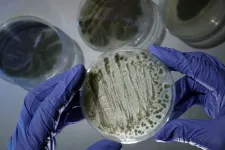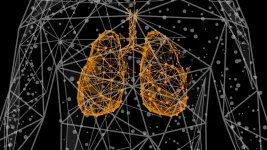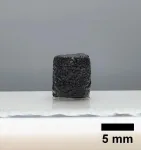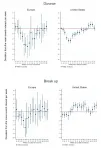(Press-News.org) Aspergillus fumigatus kills as many people as malaria and tuberculosis, but is less known. It is found "everywhere", for example in the soil or in our compost, but is not normally dangerous to healthy people.
Those who die from it often have a poor immune system or are hospitalized for lung infections, such as covid-19.
Aspergillus also constitutes an increasing problem in agriculture, because the fungus causes deadly infections in both plants and animals. In the same way that many bacteria are resistant to antibiotics, also this fungus is now becoming more and more resistant to the limited repertoire of treatments. It is therefore important to find new ways to fight fungal infections.
Researchers at the Department of Biomedicine at the Faculty of Medicine, UiB, together with researchers at the Faculty of Mathematics and Natural Sciences and a German research team, have now discovered an enzyme on the surface of the fungus.
The newly discovered enzyme breaks down a vital molecule that is important for the cells' energy metabolism: the NAD molecule, which is formed in our body from vitamin B3.
Without NAD, cells cannot survive. Therefore, the breakdown of NAD could affect immune cells and weaken our immune system to fight the fungal infection.
Recollected old scientific observations
Similar enzymes are found in bacteria that cause infections such as tuberculosis, streptococci or cholera. The idea that also fungi may have an NAD-degrading enzyme on their surface has been raised already in the 1950's:
"Enzyme activity that degrades NAD had been detected on the surface of a fungus, only the identity of the enzyme was never established. However, that fungus is commonly used in research laboratories and not known to be pathogenic. Probably, this discovery therefore went into the archive", says Professor Mathias Ziegler, leader of the study.
They want to re-examine the hypothesis that an enzyme, which breaks down NAD, may contribute to pathogenic mechanisms in fungi such as Aspergillus fumigatus.
"We measured strong enzyme activity on the surface of spores from Aspergillus fumigatus. It surprised us", says researcher and first author Øyvind Strømland.
Modern technology makes it possible to study the enzyme
"Using an elegant biochemical method, we identified fragments of the protein sequence from this enzyme. Since the entire genome of the fungus is known, we could then use these fragments to identify the gene that encodes the enzyme", says Ziegler.
"The next step was to use the genetic information and create a version of this gene that can be used by laboratory cell lines "trained" to produce sufficient amounts of the protein for detailed molecular studies", he continues.
In this way, researchers have been able to study how the enzyme breaks down NAD.
"There are two things that are central here. Highly sensitive analytical technology enabled identification of enzyme fragments. The other important element is that we now have the genome sequence and could easily identify the gene. That was not possible in the 50s", says Ziegler.
May design new drugs against the fungus
The researchers are clear that even though it is known from other diseases that similar bacterial enzymes break down NAD in infected cells, it cannot be said for sure that this is the case with the enzyme from Aspergillus fumigatus.
However, they know a lot more about the enzyme now through their research, and the hope is that the knowledge can help to discover new treatments for fungal infections.
Intriguingly, their bioinformatics analyses revealed that this type of enzyme is predominantly present in pathogenic fungi.
"If we could make a drug with molecules that resemble NAD, they might block the enzyme in our cells", the researchers suggest.
INFORMATION:
March 19, 2021, Bristol, UK - A new peer-reviewed study published in the journal Toxicological Research & Application shows acute exposure of a 3D human bronchial tissue model to e-cigarette aerosol has minimal impact on gene expression compared to smoke from combustible cigarettes.
The research involved sub-cytotoxic exposure to cells in a 3D human bronchial model (MucilAirTM) to nicotine-containing vape aerosol, combustible cigarette smoke and fresh air control under strict laboratory conditions.
The highly sensitive Toxicity Testing in the Twenty-First Century (TT21C)-based technique allows researchers to gain a ...
Approximately 8 out of every 10 health professionals in Spain are willing to be vaccinated against COVID-19, according to a study led by researchers from the Universitat Oberta de Catalunya (UOC). Published in the open-access journal Vaccines, the study assessed for the first time this population segment's willingness to be vaccinated against SARS-CoV-2 and concluded that the level of acceptance is higher among physicians than among nursing staff. Among the reasons given by health personnel for not wanting to be immunized, fears about the vaccines' safety and the potential side effects stood out.
Although vaccination is considered to the most effective method for preventing and eradicating viral infections and stopping ...
The risk of being bullied at work is twice as high if you were born abroad. And if you come from a culture that is culturally dissimilar to Sweden's, the risk is even higher. These are the results of a Swedish study from Linköping University that was recently published in The International Journal of Human Resource Management.
Employers in Sweden have a duty to ensure that the workplace is safe, with a healthy atmosphere. Despite this, some employees are treated poorly, excluded and ignored. When such treatment has continued for a longer period, it is defined as bullying.
Researchers at Linköping University wanted to see if people born abroad run a greater risk of being bullied at work.
"Our results show an increased risk of bullying ...
The headquarter of a eukaryotic cell is the nucleus, and most of the cell's information and instructions are stored there in the form of DNA (Deoxyribonucleic acid). The DNA, which is twisted, rolled and bundled two-meter-long chain, together with protein molecules, makes up the chromatin fiber that lays inside the nucleus. For years, scientists were curious how these components are organized. How is it possible that proteins necessary in biochemical reactions move efficiently within the nucleus full of DNA? Recent studies have finally solved the mystery. Findings describing it in detail were published in the Journal of Physical Chemistry Letters on December 21st, 2020.
Molecules ...
Stay tuned for the hottest science in the prevention of heart disease at ESC Preventive Cardiology 2021, an online scientific congress of the European Society of Cardiology (ESC). The annual congress of the European Association of Preventive Cardiology (EAPC), a branch of the ESC, takes place 15 to 17 April online.
Preventive cardiology covers how to avoid first and subsequent heart attacks and strokes. It also includes sports cardiology, primary care, epidemiology and population science, basic and translational research, and rehabilitation after an event. Explore the scientific programme.
Novel research will be presented including new insights into the connections between diet, exercise, and cardiovascular health. How does shift work affect the body? And are there links between climate ...
Solar energy is a clean, renewable source of electricity that could potentially play a significant part in fulfilling the world's energy requirements, but there are still some challenges to fully capitalizing on this potential. Researchers looked into some of the issues that hamper the uptake of solar energy and proposed different policies to encourage the use of this technology.
Installing solar panels to offset energy costs and reduce the environmental impact of their homes has been gaining popularity with homeowners in recent years. On a global scale, an increasing number of countries are similarly encouraging the installation of solar photovoltaics ...
CHAMPAIGN, Ill. -- A camera-trap study in the Mendocino National Forest in Northern California reveals that black bears are adept at finding and stealing the remains of adult deer killed by pumas. This "kleptoparasitism" by bears, as scientists call it, reduces the calories pumas consume in seasons when the bears are most active. Perhaps in response to this shortage, the pumas hunt more often and eat more small game when the bears are not in hibernation.
The findings are published in the journal Basic and Applied Ecology.
Pumas, also known as mountain lions or cougars, are apex ...
Due to their tissue-like mechanical properties, hydrogels are being increasingly used for biomedical applications; a well-known example are soft contact lenses. These gel-like polymers consist of 90 percent water, are elastic and particularly biocompatible. Hydrogels that are also electrically conductive allow additional fields of application, for example in the transmission of electrical signals in the body or as sensors. An interdisciplinary research team of the Research Training Group (RTG) 2154 "Materials for Brain" at Kiel University (CAU) has now developed a method to produce hydrogels with an excellent level of electrical conductivity. What makes this method special is that the mechanical properties of ...
Google Trends reveal how searches related to family and relationship behaviors, such as weddings, contraception, and abortions, changed during lockdowns in the US and Europe.
INFORMATION:
Link to publicly available article: https://journals.plos.org/plosone/article?id=10.1371/journal.pone.0248072
Funding: The authors received no specific funding for this work.
Competing Interests: The authors have declared that no competing interests exist.
Article URL: https://journals.plos.org/plosone/article?id=10.1371/journal.pone.0248072
...
How did life begin on Earth and could it exist elsewhere? Researchers at Simon Fraser University have isolated a genetic clue--an enzyme known as an RNA polymerase--that provides new insights about the origins of life. The research is published today in the journal Science.
Researchers in SFU molecular biology and biochemistry professor Peter Unrau's laboratory are working to advance the RNA World Hypothesis in answer to fundamental questions on life's beginnings.
The hypothesis suggests that life on our planet began with self-replicating ribonucleic acid (RNA) molecules, capable of not only carrying genetic information but also driving chemical reactions essential for life, prior to the evolution ...








